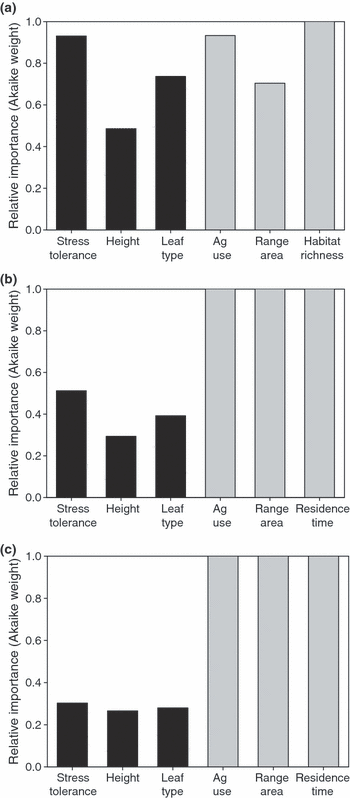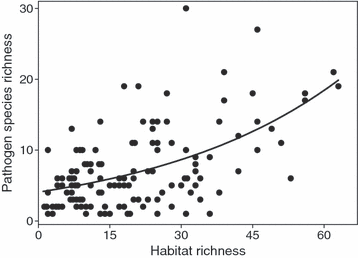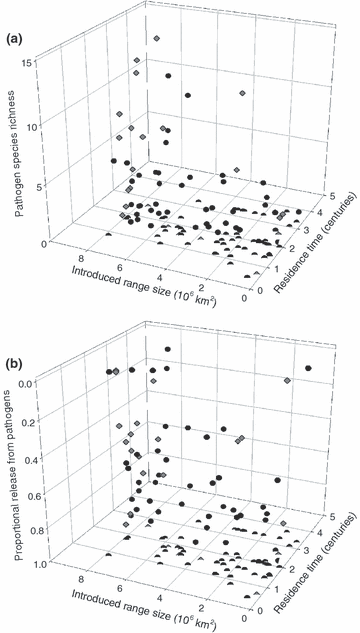Controls on pathogen species richness in plants' introduced and native ranges: roles of residence time, range size and host traits
- PMID: 20973907
- PMCID: PMC3003901
- DOI: 10.1111/j.1461-0248.2010.01543.x
Controls on pathogen species richness in plants' introduced and native ranges: roles of residence time, range size and host traits
Abstract
Introduced species escape many pathogens and other enemies, raising three questions. How quickly do introduced hosts accumulate pathogen species? What factors control pathogen species richness? Are these factors the same in the hosts' native and introduced ranges? We analysed fungal and viral pathogen species richness on 124 plant species in both their native European range and introduced North American range. Hosts introduced 400 years ago supported six times more pathogens than those introduced 40 years ago. In hosts' native range, pathogen richness was greater on hosts occurring in more habitat types, with a history of agricultural use and adapted to greater resource supplies. In hosts' introduced range, pathogen richness was correlated with host geographic range size, agricultural use and time since introduction, but not any measured biological traits. Introduced species have accumulated pathogens at rates that are slow relative to most ecological processes, and contingent on geographic and historic circumstance.
© 2010 Blackwell Publishing Ltd/CNRS.
Figures



Similar articles
-
Fungal pathogen species richness: why do some plant species have more pathogens than others?Am Nat. 2012 Feb;179(2):282-92. doi: 10.1086/663676. Epub 2011 Dec 20. Am Nat. 2012. PMID: 22218316
-
When there is no escape: the effects of natural enemies on native, invasive, and noninvasive plants.Ecology. 2007 May;88(5):1210-24. doi: 10.1890/06-1377. Ecology. 2007. PMID: 17536407
-
The role of viruses in biological invasions: friend or foe?Curr Opin Virol. 2011 Jul;1(1):68-72. doi: 10.1016/j.coviro.2011.05.018. Epub 2011 Jun 12. Curr Opin Virol. 2011. PMID: 22440570
-
Genes, communities & invasive species: understanding the ecological and evolutionary dynamics of host-pathogen interactions.Curr Opin Plant Biol. 2013 Aug;16(4):400-5. doi: 10.1016/j.pbi.2013.05.003. Epub 2013 Jun 6. Curr Opin Plant Biol. 2013. PMID: 23746668 Review.
-
Continua of specificity and virulence in plant host-pathogen interactions: causes and consequences.New Phytol. 2009 Aug;183(3):513-529. doi: 10.1111/j.1469-8137.2009.02927.x. Epub 2009 Jun 26. New Phytol. 2009. PMID: 19563451 Review.
Cited by
-
Early root overproduction not triggered by nutrients decisive for competitive success belowground.PLoS One. 2013;8(1):e55805. doi: 10.1371/journal.pone.0055805. Epub 2013 Jan 31. PLoS One. 2013. PMID: 23383284 Free PMC article.
-
Assortment of Flowering Time and Immunity Alleles in Natural Arabidopsis thaliana Populations Suggests Immunity and Vegetative Lifespan Strategies Coevolve.Genome Biol Evol. 2018 Sep 1;10(9):2278-2291. doi: 10.1093/gbe/evy124. Genome Biol Evol. 2018. PMID: 30215800 Free PMC article.
-
A growth-defense trade-off is general across native and exotic grasses.Oecologia. 2019 Nov;191(3):609-620. doi: 10.1007/s00442-019-04507-9. Epub 2019 Sep 21. Oecologia. 2019. PMID: 31542812
-
Tissue-Specific and Geographical Variation in Endophytic Fungi of Ageratina adenophora and Fungal Associations With the Environment.Front Microbiol. 2019 Dec 18;10:2919. doi: 10.3389/fmicb.2019.02919. eCollection 2019. Front Microbiol. 2019. PMID: 31921082 Free PMC article.
-
Native perennial and non-native annual grasses shape pathogen community composition and disease severity in a California grassland.J Ecol. 2021 Feb;109(2):900-912. doi: 10.1111/1365-2745.13515. Epub 2020 Oct 8. J Ecol. 2021. PMID: 34158675 Free PMC article.
References
-
- Anderson PK, Cunningham AA, Patel NG, Morales FJ, Epstein PR, Daszak P. Emerging infectious diseases of plants: pathogen pollution, climate change and agrotechnology drivers. Trends Ecol. Evol. 2004;19:535–544. - PubMed
-
- Blomberg SP, Garland T, Ives AR. Testing for phylogenetic signal in comparative data: behavioral traits are more labile. Evolution. 2003;57:717–745. - PubMed
-
- Brändle M, Kühn I, Klotz S, Belle C, Brandl R. Species richness of herbivores on exotic host plants increases with time since introduction of the host. Divers. Distrib. 2008;14:905–912.
-
- Burnham KP, Anderson DR. Model Selection and Multimodel Inference: A Practical Information-Theoretic Approach. New York: Springer; 2002.
Publication types
MeSH terms
LinkOut - more resources
Full Text Sources
Molecular Biology Databases

